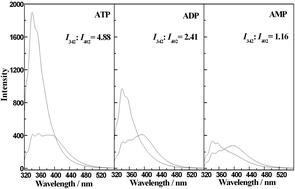The 2-phenylbenzimidazole-5-sulfonate/layered double hydroxide co-intercalation composite and its luminescence response to nucleotides†
Abstract
Fluorescence sensing of nucleotides is an important topic for biosensor and fluorescence materials. In this paper, a cheap UV light absorber, 2-phenylbenzimidazole-5-sulfonate (PBS) was immobilized into the interlayers of Zn2Al layered double hydroxides (LDHs) by co-intercalating with 1-decane sulfonate (DES) anions. The dependence of fluorescence on the molar concentration (x%) of PBS was investigated, and the PBS(15%)–DES/LDH composite exhibited optimal violet luminescence at 402 nm, compared with that of the PBS solution with luminescence at 342 nm. The PBS(15%)–DES/LDH composite thin films were fabricated by solvent evaporation method on quartz substrate. Moreover, the composite thin film exhibited remarkable PBS luminescence transformation (violet to UV light) for nucleotide triphosphates (ATP, GTP, CTP and UTP), compared with their diphosphate and monophosphate counterparts (ADP, AMP and etc.), which makes it a prospective sensor for the nucleotide molecules at the simulated physiological conditions. The origin of the luminescence enhancement was investigated and attributed to the extensive hydrogen bonding interaction between the intercalated PBS and nucleotides.


 Please wait while we load your content...
Please wait while we load your content...